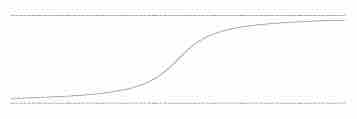The asymptotes are most commonly encountered in the study of calculus of curves of the form
Horizontal asymptotes are horizontal lines that the graph of the function approaches as

Horizontal asymptote
The graph of a function can have two horizontal asymptotes. An example of such a function would be
Vertical asymptotes are vertical lines (perpendicular to the
Oblique asymptotes are diagonal lines so that the difference between the curve and the line approaches
Only open curves that have some infinite branch, can have an asymptote. No closed curve can have an asymptote.